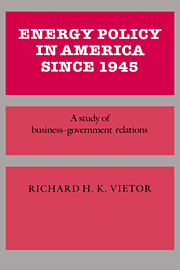Book contents
- Frontmatter
- Contents
- List of charts and figures
- List of tables
- Editors' preface
- Acknowledgments
- List of abbreviations
- 1 Introduction: The political economy of energy
- Part I The transition to peace and fluid fuels, 1945–1958
- Part II Managing surplus through the politics of stasis, 1959–1968
- 6 Oil import quotas
- 7 Formula for shortage: natural gas price controls
- 8 Synfuels revisited: nostrum for the coal industry
- Part III The second energy transition: adjustment to depletion, 1969–1980
- Index
8 - Synfuels revisited: nostrum for the coal industry
Published online by Cambridge University Press: 13 October 2009
- Frontmatter
- Contents
- List of charts and figures
- List of tables
- Editors' preface
- Acknowledgments
- List of abbreviations
- 1 Introduction: The political economy of energy
- Part I The transition to peace and fluid fuels, 1945–1958
- Part II Managing surplus through the politics of stasis, 1959–1968
- 6 Oil import quotas
- 7 Formula for shortage: natural gas price controls
- 8 Synfuels revisited: nostrum for the coal industry
- Part III The second energy transition: adjustment to depletion, 1969–1980
- Index
Summary
The government's second program to develop synthetic fuels from coal evolved from ad hoc initiatives; national security was not even an excuse. The program grew out of modest congressional efforts to resuscitate the coal industry and the Interior Department's vague stewardship for oil shale. But excess capacity in crude oil and natural gas, together with stable real energy prices, was an overwhelming impediment to commercial development of synfuels. Without clear signals from the market, the private sector balked at the risks. And since government was unwilling to assume any real responsibility, as it had for nuclear power, it failed to develop and support a bureaucracy that could manage large projects successfully. From beginning to end (1959–1968), the second synfuels program floundered for lack of an effective clientele or strategic definition.
Research – the cure for a “sick industry”
By 1956, coal was a “sick industry” in more ways than one. Coal production had declined 39 percent from its peak in 1947; three thousand mines had closed, and the number of mine workers fell by nearly half. Coal's share of the energy market had fallen by 18 percent, with no end in sight. Although insufficient research was not necessarily the coal industry's principal problem, it was the most amenable to political redress. The industry's real problems – interfuel competition, adverse energy policies, and structural fragmentation, were less tractable politically. Coal-state congressmen, organized labor, and some of the industry's leaders looked to federally-sponsored research in synthetic fuels as a means of relief.
- Type
- Chapter
- Information
- Energy Policy in America since 1945A Study of Business-Government Relations, pp. 163 - 190Publisher: Cambridge University PressPrint publication year: 1984



